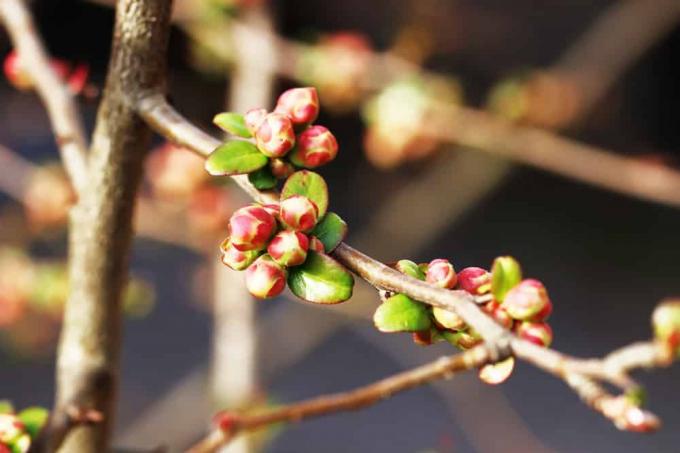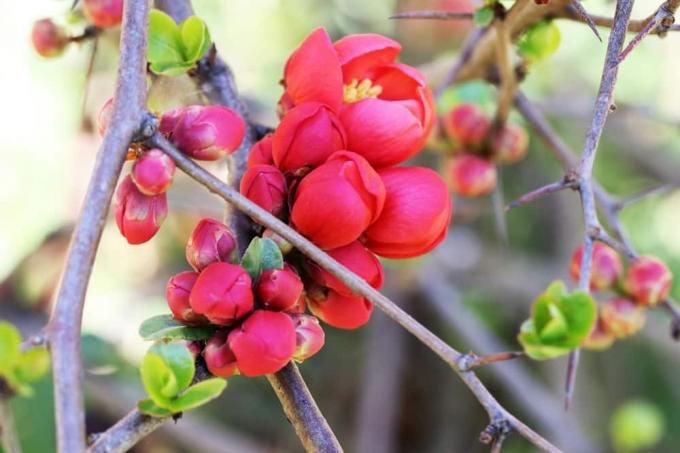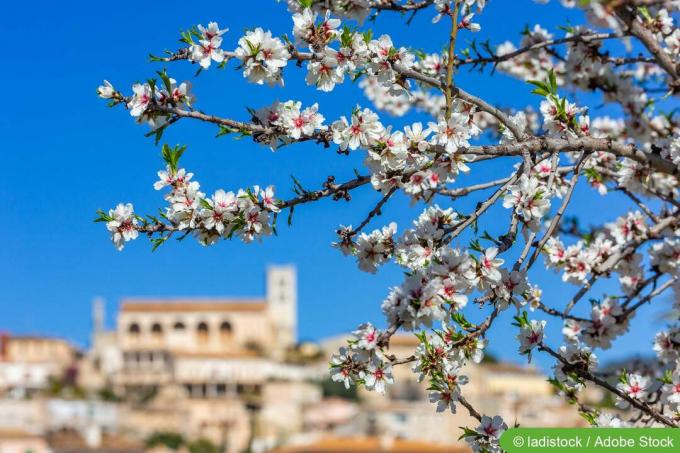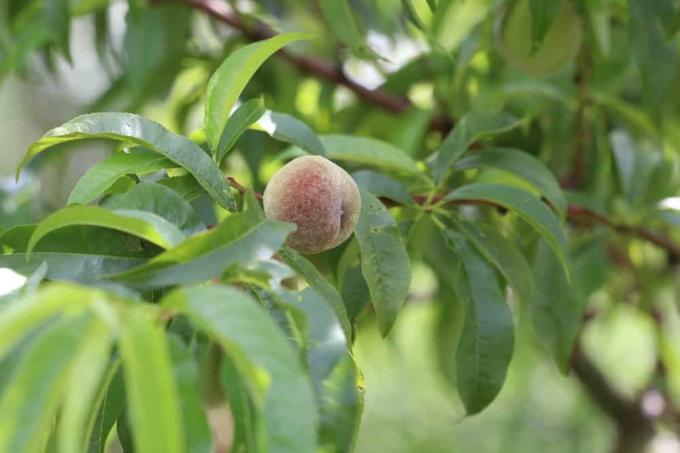

Table of contents
- Location
- substrate
- Plant
- Culture in the bucket
- Pour
- Fertilize
- waste
- propagation
- Toxic or edible?
- harvest
- Conclusion
Intensely colored flowers, a dense, lush growth and even the fruits are decorative - the ornamental quince attracts attention with its beauty - and is extremely easy to care for. Of course, a few factors must still be considered so that the thorny plant from East Asia can unfold in all its glory. With the right knowledge, however, the culture is also easily possible for beginners in garden maintenance. The following guide shows how to do it.
Location
Spoiled by light and sunny - this is what the location for the ornamental quince should look like. In its Asian homeland, the false quince also grows in bright places, so that it receives a lot of heat as well as plenty of light. The south side and places that are at least a little protected from cold winds, for example near walls and walls, are therefore ideal.
substrate
The substrate for the ornamental quince should be rich in nutrients, loamy and deep. High-quality garden soil mixed in with mature compost, manure and, if necessary, powdered clay is ideal. If the garden soil is already loamy, only compost or manure should be added for the nutrient supply. It is also advisable to dig up the soil at the planting site and apply the fertilizer at least four weeks before planting. As a result, the nutrients can be distributed and settled and can already be processed by the soil organisms.
Plant
The ornamental quince can be planted either in autumn or spring. So around April or October. Experience has shown that the quince is better planted in October, as it then grows over the winter and can sometimes bloom in the first spring. The soil is prepared as described and then watered with water to encourage the roots to grow deeper. A frost-free and dry day should be chosen to put the ornamental quince in the garden. The planting distance depends on the intended use. As a solitary plant, it should be about two meters. As a hedge, the planting distance should only be one meter. For smaller variants of the ornamental quince, the distance may be even smaller. This should be based on the growth width of the shrub.
Culture in the bucket

Smaller false quinces, such as the Japanese ornamental quince, are also wonderfully suited to being cultivated in a bucket - at least during the first few years or with regular trimmings. However, it is important to ensure that:
- the planter should be as high as possible to give the deep roots enough space
- sufficient and regular watering takes place, especially if the ornamental quince is covered
- the substrate is chosen to be rich in nutrients and fertilized or changed regularly
The culture in the tub requires a little more effort than outdoors in the garden. In addition, when choosing the planter, you should pay attention to how high and wide the selected ornamental quince species will be. The larger the bucket is at the beginning compared to the quince, the lower the maintenance effort and the longer you can wait with the first repotting.
Pour
The ornamental quince withstands occasional drought well, but it should not last too long. It is therefore poured after planting as required, when the substrate is dry in the top layers. However, waterlogging should be avoided, especially when cultivating in a bucket. Good water drainage must therefore be ensured.
If the substrate tends to compact, a drainage layer of gravel can also be installed. Coarse gravel or shards of pottery on the bottom of the pot are ideal for cultivation in a planter.
Tip:
To prevent drying out, especially at high temperatures and little rainfall, a thick layer of bark mulch can be applied to the substrate. This reduces the casting effort. However, you should then check more frequently whether the soil still contains sufficient moisture.
Fertilize
As already mentioned, the first supply of nutrients should take place during planting. After that, the ornamental quince is frugal. Annual fertilizer applications are usually not necessary. If the growth and blooming power decrease, another application of mature compost or stable manure can be done. The fertilizer is applied to the substrate around the shrub and then lightly worked into the soil. In addition, watering should be done so that the nutrients are distributed and can penetrate deep into the soil. Experience has shown that fertilization must be carried out somewhat more frequently in bucket culture. Alternatively, the ornamental quince can be repotted in fresh and nutrient-rich soil.
waste
The ornamental quince tolerates pruning well and is therefore also ideal as a hedge plant. It can be kept very narrow and only makes a few general demands on the blend. Below:
- clean cutting tool to avoid infection
- Cut off in the morning on a dry day to allow the cuts to dry quickly
- Remove as much as necessary, as little as possible

Although the quince tolerates a blend well, it does not necessarily need it. In addition, this care measure usually falls victim to many flowers. It is therefore important to note that the ornamental quince flowers on two-year-old wood. If you want to keep the flowering power, thin out the shrub only slightly and only remove older, bare twigs - but then as close to the ground as possible. The ideal time is around March or April, before the first budding.
Tip:
The ornamental quince tends to shed quickly, which is why cutting back old shoots to just above the ground has a rejuvenating effect and maintains the flowering power.
propagation
There are two ways to propagate the ornamental quince. On the one hand, the use of the seeds. However, this is tedious and often not crowned with success. Propagation via cuttings is therefore recommended.
To do this, proceed as follows:
- In spring, when the first shoots begin, or in June at the latest, shoot tips that are about 20 centimeters long are cut off.
- The tips should be cut off as diagonally as possible so that there is a large cutting surface. If the shoots are well leafed, the lower leaves are removed.
- The shoots are placed with the cut surface first about five centimeters deep in the ground. Seedling soil can be used for this or the same substrate used for the adult ornamental quince.
- Until roots develop, the cuttings are watered regularly to prevent the substrate from drying out.
If you still want to try propagation via seeds instead, free the seeds from the pulp and store them in a cool place over the winter - for example in the refrigerator. Then they are placed on potting soil, lightly covered with substrate and can be placed on a sunny windowsill from March. Kept moist and covered with cling film, they should show the first germs after a few weeks. To avoid mold and sticking, the planter is either placed in a warm, humid place or the foil cover is briefly removed and aired daily.
Toxic or edible?

The ornamental quince is a rose family, but its fruits are called apples - and are actually edible. Pure and raw, however, they prove to be very hard. The juice pressed from it can be used in a similar way to lemon juice and the fruits can be used to make jam. Due to the low sugar and high pectin content, they are also ideal for preserving with sweet fruit varieties.
harvest
The fruits of the ornamental quince ripen very slowly. Only in autumn do they slowly become ready for harvest. Indications of this are a golden yellow to reddish color and a very aromatic smell. If they are harvested now, before the first frost, they will keep for several weeks or even months in a cool and dark place.
If you like it a little sweeter, wait until the first frost before harvesting. After that, the ornamental quince fruits should be processed quickly. They only last a few days.
Tip:
If a few apples get stuck on the quince, the birds use them as food.
Conclusion
The ornamental quince is an easy-care shrub that does not overwhelm even beginners in gardening. Neither fertilization nor a blend are necessary. The plant can be planted as a single shrub or hedge and will give pleasure for a long time without requiring much effort.
 garden editorial
garden editorial I write about everything that interests me in my garden.
Learn more about fruit trees

Life on Mallorca: highlight almond blossom
Life on Mallorca offers a lot more than sun, summer, beach and Ballermann. The beginning of the year on the popular holiday island is all about blossoming almond trees. We'll tell you when and where you can best enjoy the almond blossom on Mallorca.

Cutting sour cherries: 21 tips for the right cut
In order for a sour cherry to remain productive year after year, it must be pruned regularly. Wood that has been removed must be removed and new fruit wood must be promoted. This only works if the "editor" knows the editing rules.

Is the ornamental peach edible? | 15 tips for care and cutting
The ornamental peach can be a decorative addition to the garden as early as March, when the trees, which are up to three meters high, are in bloom. Here we tell you how to look after them and whether their fruits are edible.

20 old apple varieties | List of old apples in & around Germany
Hardly any type of fruit is as diverse as the apple. The number of apple varieties worldwide is estimated at over 20,000. Old apple varieties are those that were discovered before 1950. We have compiled a list of popular, old varieties for you.

Peach Tree Diseases: Leaves curl or turn yellow
Among the fruit trees, the peach tree is one of the most susceptible to diseases. It often has to contend with fungal diseases such as curling disease. Here you can find out which other tree diseases can affect it, how to recognize them and how to fight them successfully.

Half-trunk cherry and apple trees: planting distance and care
Fruit trees definitely belong in every garden. But what to do if the garden is too small for a large tree? Then trees that were grown as half-stems can help. They take up less space, but deliver lots of fruit. More about this here.

